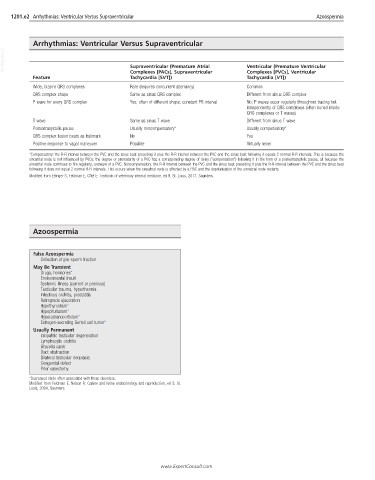Page 2425 - Cote clinical veterinary advisor dogs and cats 4th
P. 2425
1201.e2 Arrhythmias: Ventricular Versus Supraventricular Azoospermia
Arrhythmias: Ventricular Versus Supraventricular
VetBooks.ir Supraventricular (Premature Atrial Ventricular (Premature Ventricular
Feature Complexes [PACs], Supraventricular Complexes [PVCs], Ventricular
Tachycardia [SVT])
Tachycardia [VT])
Wide, bizarre QRS complexes Rare (requires concurrent aberrancy) Common
QRS complex shape Same as sinus QRS complex Different from sinus QRS complex
P wave for every QRS complex Yes; often of different shape; constant PR interval No; P waves occur regularly throughout tracing but
independently of QRS complexes (often buried inside
QRS complexes or T waves)
T wave Same as sinus T wave Different from sinus T wave
Postextrasystolic pause Usually noncompensatory* Usually compensatory*
QRS complex fusion beats as hallmark No Yes
Positive response to vagal maneuver Possible Virtually never
*Compensatory: the R-R interval between the PVC and the sinus beat preceding it plus the R-R interval between the PVC and the sinus beat following it equals 2 normal R-R intervals. This is because the
sinoatrial node is not influenced by PVCs; the degree or prematurity of a PVC has a corresponding degree of delay (“compensation”) following it in the form of a postextrasystolic pause, all because the
sinoatrial node continues to fire regularly, unaware of a PVC. Noncompensatory: the R-R interval between the PVC and the sinus beat preceding it plus the R-R interval between the PVC and the sinus beat
following it does not equal 2 normal R-R intervals. This occurs when the sinoatrial node is affected by a PAC and the depolarization of the sinoatrial node restarts.
Modified from Ettinger S, Feldman E, Côté E: Textbook of veterinary internal medicine, ed 8, St. Louis, 2017, Saunders.
Azoospermia
False Azoospermia
Collection of pre-sperm fraction
May Be Transient
Drugs, hormones*
Environmental insult
Systemic illness (current or previous)
Testicular trauma, hyperthermia
Infectious orchitis, prostatitis
Retrograde ejaculation
Hypothyroidism*
Hypopituitarism*
Hyperadrenocorticism*
Estrogen-secreting Sertoli cell tumor*
Usually Permanent
Idiopathic testicular degeneration
Lymphocytic orchitis
Brucella canis
Duct obstruction
Bilateral testicular neoplasia
Congenital defect
Prior vasectomy
*Decreased libido often associated with these disorders.
Modified from Feldman E, Nelson R: Canine and feline endocrinology and reproduction, ed 3, St.
Louis, 2004, Saunders.
www.ExpertConsult.com

